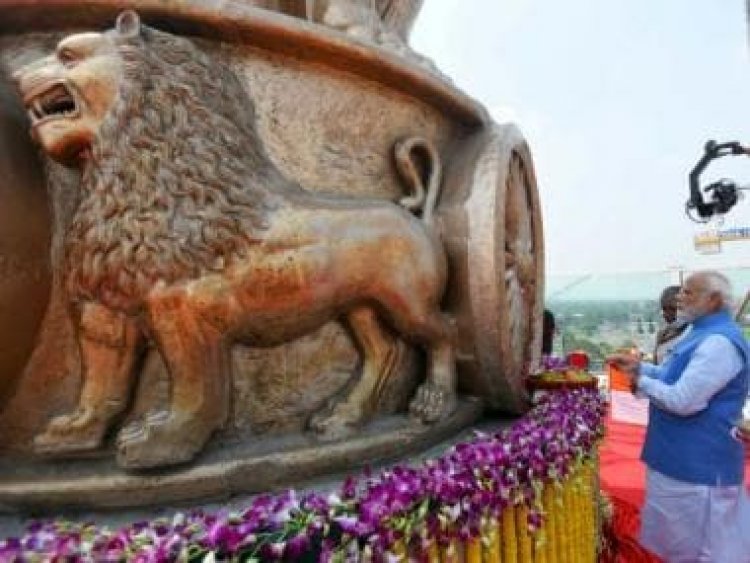9,500 kg and 6.5 metres high: All you need to know about the national emblem atop new Parliament building
9,500 kg and 6.5 metres high: All you need to know about the national emblem atop new Parliament building

A milestone was achieved today in the construction of the new Parliament building with Prime Minister Narendra Modi unveiling the national emblem cast on the roof of the new construction.
Prime Minister Narendra Modi was joined by Lok Sabha Speaker Om Birla, Rajya Sabha Deputy Chairman Harivansh and Urban Development Minister Hardeep Singh Puri at the event.
This morning, I had the honour of unveiling the National Emblem cast on the roof of the new Parliament. pic.twitter.com/T49dOLRRg1
— Narendra Modi (@narendramodi) July 11, 2022
The Centre has maintained that Parliament’s Winter session will be held at the new building, which, as per plans, will be a four-storey structure with a seating capacity of 1,224, at a cost of Rs 970 crore. The new structure, triangular in shape, would be an intrinsic part of the vision of ‘Aatmanirbhar Bharat’.
Also read: What’s in a name? How new Parliament building is at the centre of naming row
Here’s what we know of the emblem installed today and its significance.
All about the emblem
The national emblem has been cast at the top of the central foyer of the new Parliament building, and a supporting structure of steel weighing around 6,500 kg has been constructed to support it.
According to officials, the emblem is made up of bronze and has a total weight of 9,500 kg and measures 6.5 metres in height.
Over 100 artisans from across the country worked tirelessly on the design, crafting and casting of the emblem for the past six months.
Officials said that the four lions are mounted back-to-back on a circular abacus and the frieze of the abacus is adorned with sculptures of an elephant, a galloping horse, a bull, and a lion separated by intervening Dharma Chakras.
The process of casting the emblem was challenging and time-consuming. People involved in the project said that there were eight stages — from a computer graphic sketch to finally the bronze cast.
The process of the emblem began with a computer graphic sketch and based on that a clay model was created. Next came the FPR Model, followed by the lost wax process and finally the bronze cast.
Officials said that to cast the clay into bronze, a mould is made from the model, and the inside of this negative mould is brushed with melted wax to the desired thickness of the final bronze structure. After removal of the mould, the resultant wax shell is filled with a heat-resistant mixture. Wax tubes, which provide ducts for pouring bronze during casting and vents for the gases produced in the process, are fitted to the outside of the wax shell. Metal pins are hammered through the shell into the core to secure it. Next, the prepared wax shell is completely covered in layers of heat-resistant fibre reinforced plastic, and the whole is inverted and placed in an oven. During heating, the plaster dries and the wax runs out through the ducts created by the wax tubes. The plaster mould is then packed in sand, and molten bronze is poured through the ducts, filling the space left by the wax. When it is cooled, the outer plaster and core are removed, and the bronze may receive finishing touches.
Finally the statue is polished and breezed and ready with clear coat of protective polish and no paint to showcase the rich metal.
News agency ANI reported that to take the emblem to the roof, it was divided into over 150 segments and assembled on the roof. “The work to assemble it started in April end. It took us nearly two months to complete the work,” said the CPWD official.
Modi praises workers
Prime Minister Narendra Modi also met the workers involved in the building’s construction and told them that they should feel proud of their work.
I had a wonderful interaction with the Shramjeevis who have been involved in the making of the Parliament. We are proud of their efforts and will always remember their contribution to our nation. pic.twitter.com/p4LUFmCTDx
— Narendra Modi (@narendramodi) July 11, 2022
News agency PTI reported that when Modi asked them if they feel that they are making a building or history, they said in a chorus, “History”.
He also asked them about the difference they felt about being part of the construction of the Parliament building and working at some other projects. The group of workers said they felt proud of working at the new Parliament building.
With inputs from agencies
Read all the Latest News, Trending News, Cricket News, Bollywood News,
India News and Entertainment News here. Follow us on Facebook, Twitter and Instagram.
What's Your Reaction?





























































